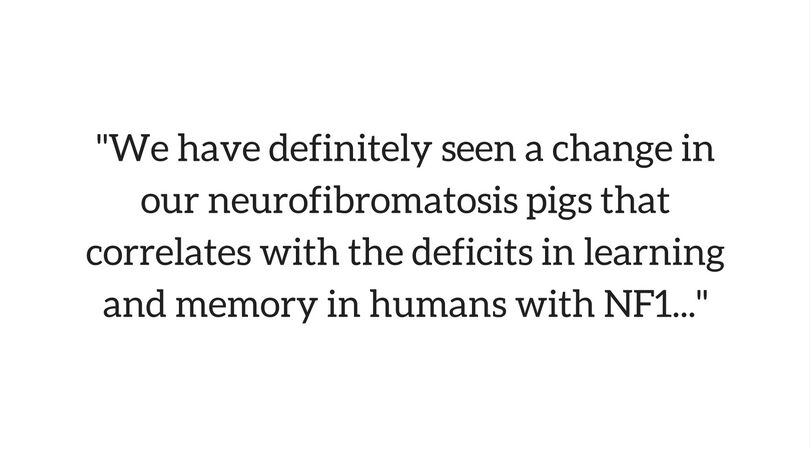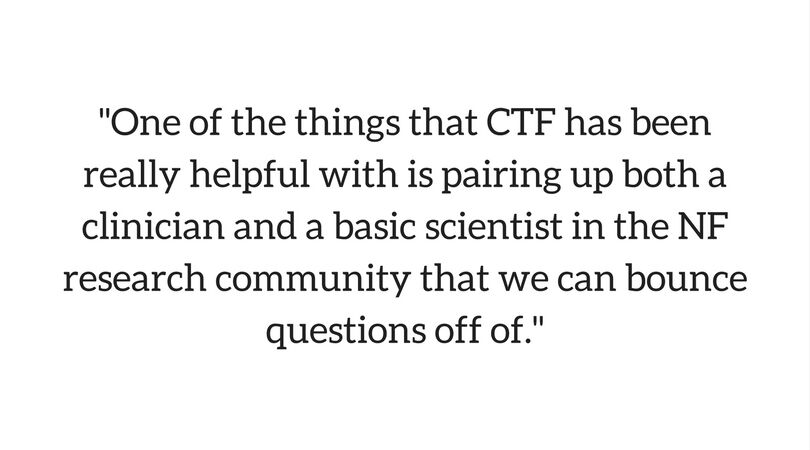In March, members of the CTF staff were treated to a talk by Synodos for NF1 Principal Investigator Jill Weimer, PhD, of the Sanford School of Medicine. Dr. Weimer discussed the swine model program currently underway, which we hope will lead to a more accurate screening of drugs to treat NF1. Below is a transcript of her talk:
I appreciate you having me. I want to circle back to what Annette said about how much of a family this group is. While I am new to CTF, I have worked with a number of foundations, and am constantly amazed with what a welcoming and collaborative group this is, especially because of the central goal set by CTF of finding cures and treatments for NF. As scientists, we often try to protect our own little territory or turf, which can sometimes create more friction than is probably needed when working towards a common goal. CTF really works on its goals and ensures that scientists work as a team. I think that really helps scientists move forward at record speed.
I’ll start by telling you a little about myself and my team. As Annette said, I am one of the leaders of one of our NF1 Synodos projects and I am located in Sioux Falls, South Dakota at Sanford Research. My team includes five investigators at the University of Iowa, and one investigator at the University of Arizona.
My job at Sanford Research is to head the therapeutic development program, and for the past decade the work in my lab has been focused on a rare disease called Battens Disease. We took a multi-role approach to studying this rare disease, with one portion of the lab focused on understanding the mechanisms that underlie the disease. And along those lines, we have been developing modules that are models, and then developing pre-clinical work in drug screening. Ultimately we can make a move from these programs to pre-clinical trials.
Some of the work we were doing on Battens Disease actually led us to NF1. One of the programs that we have at Sanford is in collaboration with Exemplar Genetics, a company that was the first to design a genetically modified pig. You might question, “Why would you do that?” One of the reasons is that when you think about drug metabolism, you need a more accurate animal model that is closer to a human than a mouse.
One situation that comes up in a lot of rare diseases is that when you introduce the same genetic modification into a mouse that would be in a man, they often don’t mimic the disease adequately. Exemplar Genetics was brought into this field because its founder was interested in Cystic Fibrosis: they had struggled for years mutating the Cystic Fibrosis genes in mice, but the mice never developed Cystic Fibrosis. So they said, “What if we actually moved to something a little more like humans?” and introduced the same mutation into the pigs, which did develop possible Cystic Fibrosis. We took the same approach at Sanford as we were interested in a number of different rare diseases, and began working in partnership with Exemplar Genetics’ pig models.
And now, more recently with the help of CTF, we have created this neurofibromatosis model. As many of you know, living with NF or being connected with the NF scientific community, mice models for NF1 lack a lot of the common characteristics that we see associated with humans with NF1. They don’t have the café au lait spots, the axillary freckling, the lisch nodules, and a lot of the devastating cancers that form in NF patients. With NF1, we are trying to develop pig modules that have a lot of these characteristics.
Actually there are a couple different research groups that are making pig models. CTF has paired us very closely with the NF1 Synodos team, headed by David Largaespada, as they are making a pig model as well. It has been nice because we are able to trade tips on how to characterize the pig model. Fortunately for this research group, the genetic mutations that they introduced were different. So we are both using pig models that are different types of mutations for NF1, and therefore not in direct competition with one another. The primary challenge in working with pigs is it takes longer to do your experiments because they are more like humans: their body size is much larger than mice and their lifespan is much longer.
So I’ll tell you where we are today. All the pigs have been born with café au lait spots, (already a step up from the mouse models). Within a few months, they often start to develop the axillary freckling that you see in NF1 patients. Some of our founder pigs are about a year and a half old, and a number of them have started to develop cutaneous fibromas. We have a veterinary pathologist that works closely with us, who has looked at some of these cutaneous fibromas that we dissected out through biopsy, and determined that they do resemble the cutaneous fibromas that you would see in NF1 patients. He has also done a lot of pathology on the café au lait spots to ensure they are actually café au lait spots, because sometimes pigs can have spots themselves. We try to use pigs that have a one color background just to make sure that any pigs producing a lot of café au lait spots pathologically mirror what you see in human mutations.
Right now we’re also doing longitudinal MRI and PET scanning so we can get really even head scans of these cutaneous fibromas. We can continue to monitor these pigs over time looking for development of any deeper tumors using scans across the central nervous system and brain, down the spinal column, and throughout the entire animal’s body. My lab is actually not an NF lab; we are a neurodevelopmental lab. So it’s exciting to have all these different labs studying the neurodevelopmental aspects and cognitive changes that are often associated with NF1. We actually took on a fairly challenging endeavor to see if we can identify a learning and memory deficit in these pigs. We developed a learning and memory test that the pigs have to go through: they have to choose a certain path to follow through a maze to get a food reward, and then they are tested again and scored based on how quickly they can learn where a new food reward is in the maze. We have definitely seen a change in our neurofibromatosis pigs that correlates with the deficits in learning and memory in humans with NF1, though I think we will need a little more work on the tests we designed.
One of the things that CTF has been really helpful with is pairing up both a clinician and a basic scientist in the NF research community that we can bounce questions off of. And the other Synodos for NF1 team has very strong clinicians and basic scientists, who are very well entrenched in the NF community. So we spend a lot of time discussing social behavior changes, things that they see in NF1 patients that we should be looking for in our pigs. A good example of this was when the whole group was in Sioux Falls for a team meeting about 6 months ago. I mentioned that one of the things we were noticing in our pigs is their social interaction or more heightened anxiety. The easiest way to explain this is that pigs are normally very inquisitive, so they’ll walk towards the front of the pen to see what you are doing in their space (they’re very territorial). They want to come up to you especially if you have a treat. The NF1 pigs stay towards the back of the pen, almost intimidated by you. I think, just by observing the pigs, that they have a social interaction deficit. Coming up with a way that we can test and record that makes it a little more challenging for us, but we’re working on it.
 Beyond the characterization of the pigs and having a really solid basis for NF1, and making those available for the NF community, we have two primary long-term goals for our group. One is coming up with a way we can actually detect a tumor much earlier in a patient by refining the technology, allowing us to get in there and dissect it before it is too late. One of the investigators at the University of Iowa is a biomechanical engineer focusing on refining MRI, combined with overlay of PET for advanced imaging technology. She’s looking for texture changes that can be detected and monitored very, very early. That would be one component.
Beyond the characterization of the pigs and having a really solid basis for NF1, and making those available for the NF community, we have two primary long-term goals for our group. One is coming up with a way we can actually detect a tumor much earlier in a patient by refining the technology, allowing us to get in there and dissect it before it is too late. One of the investigators at the University of Iowa is a biomechanical engineer focusing on refining MRI, combined with overlay of PET for advanced imaging technology. She’s looking for texture changes that can be detected and monitored very, very early. That would be one component.
The other component that I haven’t yet mentioned is from our colleague at the University of Arizona. He is focused on peripheral and migraine pain in NF patients. Over the last 3-4 years, he worked closely with CTF, and knows the number of drug compounds that he feels can modulate peripheral and migraine pain. So our next challenge is doing the behavioral characterization on the pigs to look for both peripheral and migraine pain, and then to use his drug compound to see if we can correct that. He has also focused on looking for biomarkers for NF1 and particularly for the fraction of NF patients that then go on to develop different types of cancers. CTF has paired him up with the biomarker program that they developed, so he’s doing everything in parallel with that program. That will be a sort of auxiliary program that will develop out of this partnership as well.
That’s where we are right now. We have confirmed at the very basic cell level that the mutations create the cellular changes that one would see with NF1: we’re seeing café au lait spots and the formation of cutaneous neurofibromas, we’re seeing learning and memory deficits. So really what we’ve been able to develop is a more accurate model of neurofibromatosis that I think will be very, very useful to the community, for drug testing, for advanced imaging technology, and for early diagnosis of NF1.

